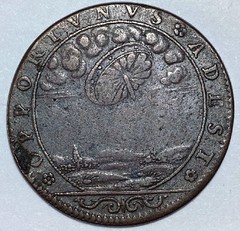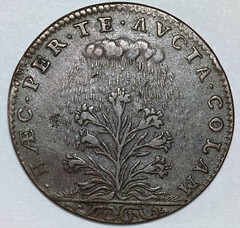For example, here are links to some of this speculation:
I really made an impression on that collector when I finally decoded this mystery. The design of that jeton was inspired by a story from the mythical early days of the Roman Republic, and after I came up with the real explanation he shared it with others and it finally reached the Internet:
The design depicts Numa's Shield falling from the sky, sent by the gods to protect and save the land from disaster.
from Plutarch's Lives, Volume I:
"In the eighth year of Numa's reign an epidemic raged throughout Italy, and afflicted the city of Rome. Now amidst the general distress it is related that a brazen shield fell from heaven into the hands of Numa. Upon this the king made an inspired speech, which he had learned from Egeria and the Muses. The shield, he said, came for the salvation of the city, and they must guard it, and make eleven more like it, so that no thief could steal the one that fell from heaven, because he could not tell which it was. Moreover the place and the meadows round about it, where he was wont to converse with the Muses, must be consecrated to them, and the well by which it was watered must be pointed out as holy water to the vestal virgins, that they might daily take some thence to purify and sprinkle their temple. The truth of this is said to have been proved by the immediate cessation of the plague. He bade workmen compete in imitating the shield, and, when all others refused to attempt it, Veturius Mamurius, one of the best workmen of the time, produced so admirable an imitation, and made all the shields so exactly alike, that even Numa himself could not tell which was the original. He next appointed the Salii to guard and keep them."
The actual ancilia were twelve "figure 8" shaped shields of the type used by spearmen in early Classical times, who fought in line for many centuries before the full development of the phalanx and adoption of the round shield (hoplon). There was a good depiction of this formation in the film Troy.
"Figure 8" spearman's shield
On denarii of P. Stolo, of the Licinia family [one of the moneyers of Augustus] is a reverse type of the ancilia, between which is the apex, or cap, of one of the Salii, with the legend P. STOLO. III. VIR.
The obverse depicts Augustus with the legend AVGVSTVS TR. POT.
Such shields of course were not used in the seventeenth century, and what was actually depicted on this unusual jeton was a contemporary buckler: a cavalryman's round shield that had a short spear point protruding from the boss in the center:
All good things must come to an end. This very interesting and studious collector eventually passed away, and his collection was sold at auction. I recognized many fine and rare "old friends" I had supplied to him in that sale.
***********************************






